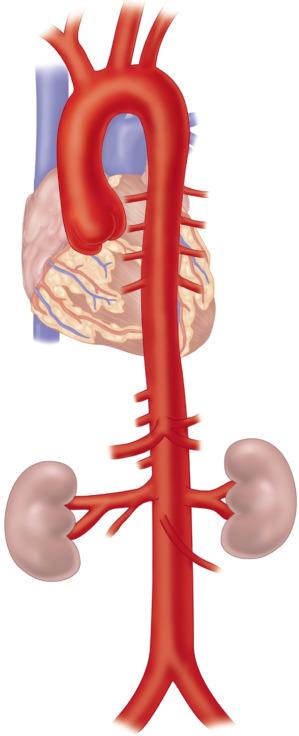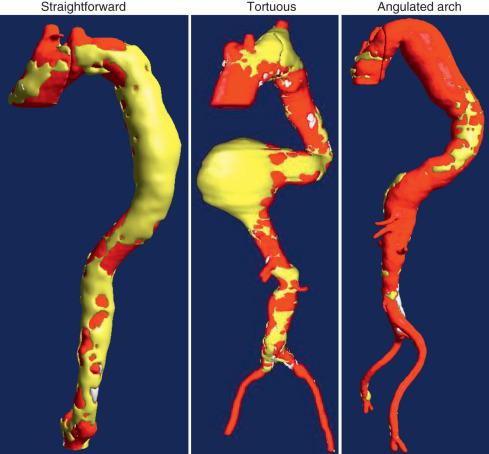Physical Address
304 North Cardinal St.
Dorchester Center, MA 02124
Thoracic endovascular aortic repair (TEVAR) has become an effective treatment for various descending thoracic aortic pathologic processes, including aortic aneurysm and dissection. Although long-term outcome data for this therapy are not available, the short-term and intermediate results have been promising. Long-term data is accumulating and appears to be comparable to open surgery.
Multiple devices have been investigated and approved in multicenter trials. Multiple iterations and advance in endograft design have helped navigate anatomic limitations. With ongoing improvements in imaging and with the development of branched endografts in particular, surgeons will be able to offer endovascular therapy for the aortic arch and thoracoabdominal aorta to an increased population of patients when appropriate.
Beginning distal to the left subclavian artery, the descending thoracic aorta is the continuation of the aortic arch. As it descends through the posterior mediastinum, the descending thoracic aorta lies to the left of the vertebral bodies and gradually approaches the midline. At the level of the 12th vertebra, it passes through the aortic hiatus in the diaphragm and becomes the abdominal aorta ( Fig. 27.1 ).

Anterior branches of the descending thoracic aorta include bronchial and esophageal arteries. These branches continue as the segmental arterial supply to their respective structures. Intercostal arteries are posterior branches along the length of the descending thoracic aorta and provide segmental arterial blood supply to the spinal cord.
In most patients, a dominant anterior medullary artery, the artery of Adamkiewicz, arises between levels T7 and L1 and provides most of the blood supply to the anterior spinal artery, perfusing the anterior two-thirds of the spinal cord. Anteriorly, the intercostal arteries continue along the inferior margins of the ribs and form collaterals with the internal thoracic arteries located at the anterior chest wall.
There are no major arterial branches in the descending thoracic aorta, enabling the treatment of the entire descending thoracic aorta with TEVAR. The first major branch is the celiac artery, which arises in the abdominal aorta to supply the upper gastrointestinal tract. However, complete coverage of the entire descending thoracic aorta, including the left subclavian artery, is associated with an increased risk of stroke and spinal cord ischemia.
Careful preoperative planning with appropriate imaging is essential for TEVAR. Preoperative assessment must address two important issues: anatomic requirements and vascular access. The gold standard is computed tomography (CT) angiography of the thorax, abdomen, and pelvis, with distal arterial runoffs. Thin-slice helical CT scanning with 2-mm slices is ideal to create three-dimensional reconstructions of the aorta. In patients with contraindications to intravenous contrast, magnetic resonance angiography is an acceptable alternative.
Anatomic requirements center on the suitability of the proximal and distal landing zones. TEVAR involves the deployment of an intraluminal endoprosthesis resulting in the exclusion of the thoracic aneurysm. Therefore, the essential requirement is suitable proximal and distal landing zones to achieve an adequate seal and prevent endoleaks.
The evaluation for the suitability of the landing zones involves two major criteria, the length of the zone and the aortic diameter. Although device-specific, the length of the landing zone must be sufficient to achieve adequate exclusion. For most devices, the requirement is 2 cm of aorta without significant tapering. The aortic diameter must safely accommodate a self-expanding endovascular device. For aneurysmal disease, the device should be upsized (compared with the diameter of the landing zone) by 10% to 20% to achieve adequate exclusion. Current devices allow safe treatment for aortic diameters between 18 and 43 mm.
For nonaneurysmal disease, such as dissection or traumatic transection, less aggressive upsizing (< 10%) is generally recommended.
Additional factors to consider in the evaluation of the landing zones include the presence of thrombus, rapid tapering, calcification, tortuosity, and angulation ( Fig. 27.2 )

Circumferential thrombus and extensive calcification at a landing zone may not allow adequate seal, resulting in endoleaks.
Minimal tapering of the aortic diameter over the length of the landing zone (< 15%), with minimal tortuosity and angulation, are also desirable to ensure adequate exclusion.
Angulation is often a proximal landing zone issue at the level of the distal arch. Severe angulation may result in so-called bird-beaking of the endograft. These and other factors may require extension of the proximal and distal landing zones. If coverage of the branch vessels is necessary at the proximal or distal landing zone, an extraanatomic bypass such as a carotid artery–subclavian artery bypass or mesenteric artery–visceral artery bypass, respectively, may be necessary. However, branched endografts that are currently undergoing feasibility trials may be appropriate in these settings in the future.
A vascular complication is a major component of the morbidity and mortality rates associated with TEVAR. Current devices require a large-caliber delivery system, typically ranging from 18 to 24 F outer diameter. Several device manufacturers are investigating low-profile devices that would potentially decrease vascular complications.
Preoperative imaging must include assessment of the iliofemoral vasculature. In addition to diameter, factors such as excessive calcification, tortuosity, history of peripheral vascular disease, and previous aortoiliac surgery may prevent safe delivery of the endograft.
If severe peripheral occlusive disease is prohibitive to the safe delivery of the endograft, endovascular balloon angioplasty may be performed preoperatively or concomitantly during TEVAR before the introduction of the delivery devices.
If femoral arterial access is inadequate, aortoiliac exposure through a retroperitoneal approach may be required. Other access alternatives include the subclavian artery, carotid artery, direct aortic approach, and transapical
Become a Clinical Tree membership for Full access and enjoy Unlimited articles
If you are a member. Log in here